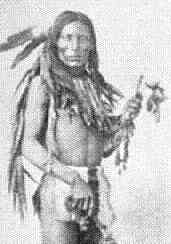

Civilization and Insanity
Paulo Dalgalarrondo, MD, PhD

The idea that insanity is rare among primitive people and that it tends to increase in proportion to the civilizing process first appeared in the 19th century. Important psychiatrists of that time defended the idea that there is an intimate relation between civilization and mental illness. The notion about the "good savage", proposed by the French philosopher and reformer Rosseau, was still strong.
For example, the German naturalist Alexander von Humboldt, in his trip to the tropical regions of America had been surprised by the absence of mentally ill among the savages. In another example, the doctor in charge of the removal of the Cherokee Indians to the Indian reservations observed more than 20 thousand Indians and he came to the conclusion that he had never seen or even heard about any case of insanity among the Cherokees. It was also believed that insanity was rare among the African and the Chinese, and the native peoples in the South Pacific were also exempt from insanity. Captain Wilkes, the Commander of the "United States Exploring Expedition". relates that during all of his voyage to the southern seas he had not seen any case of insanity among the people of that region.
Mental Diseases in the Native People
However, the idea of complete absence of mental disease among the primitives would not hold ground. During the course of the 19th century and parallel to the expansion of English, French and Dutch colonialism, alienists in the colonies began to notice better the contrast between patients seen there and those seen in Europe. They started to discover mental diseases that were restricted to primitive people, such as the Amok and the Latah, among the natives of Java; Koro, among the Chinese in Java , the Myriath, in Siberia; Piblokto among the Eskimos; etc. Thus, a new approach was born, the so-called "cultural psychiatry of the exotic", which evolved to the present concept of culture-bound syndrome.
At this time there is also the interest of some European psychiatrists in demonstrating that the classical illnesses described by them, such as schizophrenia, were universal and not limited geographically to Europe. For the first time, psychiatry sought outside its birthplace a proof of the universal value of its categories of mental disease. The great German psychiatrist Emil Kraepelin was one of the first to make extensive travels to the Far Orient and to examine psychotic patients among primitive people, such as in the island of Java.
Finally, during the century of expansion of the great empires, the idea predominated that civilization has a noxious effect upon the mental health of the so-called Primitive. The introduction of alcohol into native culture was considered as one of the principal elements in the destruction of the indigenous American tribes. And why was so ?
Racism and the brain of the native
Since the middle of the 19th century, causal theories about mental illnesses oscillated between organic and psychological views. Organic ideas came to predominate, marked principally by the theory of degeneration of the brain. Attuned to the "brain mythology" of the epoch, there arose the idea that the brain of the natives was more primitive than that of the European and that it resembled the brain of a child, or that they manifested an innate cerebral inferiority, inherent to the race and which made them equal to the most inferior degenerates of Europe.
Besides the idea that native people in the European colonies had a more primitive brain than Europeans, the thesis that Negroes had a brain anatomically more primitive than whites grew at the turn of the century. Negroes were thought to have a brain with diminished frontal lobes which would explain the fact of having "inferior mental faculties like smell, sight, manual ability, corporal sense and melody and whites, on the other hand, had more developed higher mental faculties like self-control, ambition, ethical and aesthetic sense and reason".
The association of the growth of organic psychiatry with racism in European colonialism and in the discriminatory ideologies of the dominant American classes, transformed the savage and the Negro from an exotic and simplistic personality into a bearer of a primitive and crude brain. Surprisingly, this bias in cultural psychiatric thinking, even though it was grossly racist and ethnocentric, was defended up to a few decades ago, principally in the ideas of psychiatrists working in the English and French colonies of Africa.
 The idea that the indigenous native
was especially vulnerable to the effects of civilization - given that his
more primitive brain could not support the damaging effects of more evolved
type of society - predominated among North and South American alienists.
In the United States many authors tried to show that the supposed increase
of mental illness among Negroes after the abolition of slavery had to do
with the lack of mental preparation of Afroamericans for life in a "free
and civilized" society. Once more, it is not historical and social
dynamics which produce unequal relationships among men and cast certain
social groups into sub-human living conditions, but the "constitutional
brain weakness" of these groups that makes that makes them easy prey
to misery and insanity.
The idea that the indigenous native
was especially vulnerable to the effects of civilization - given that his
more primitive brain could not support the damaging effects of more evolved
type of society - predominated among North and South American alienists.
In the United States many authors tried to show that the supposed increase
of mental illness among Negroes after the abolition of slavery had to do
with the lack of mental preparation of Afroamericans for life in a "free
and civilized" society. Once more, it is not historical and social
dynamics which produce unequal relationships among men and cast certain
social groups into sub-human living conditions, but the "constitutional
brain weakness" of these groups that makes that makes them easy prey
to misery and insanity.
The neurologist and psychiatrist Harry R. Hummer, the superintendent of the only exclusive sanatorium for American Indians in the U.S. in South Dakota, did the first systematic study about mental illness among alienated American Indians. For him, although generally the symptoms and type of disturbances were similar among indians and whites, among the indians there predominated cases of uncontrolability with extreme aggressiveness and homicides.
Gradually, cultural psychiatric thinking consolidated the idea that every time the native is faced with suffering, loss and frustration, his immediate tendency is to react in an infantile, hysterical and impulsive way rather than to develop more profound depressive symptoms. Perhaps the outstanding idea in cultural psychopathology since the turn of the century is that the symptoms of natives are less differentiated and elaborated, more crude, confused, disorganized and poorer in content.
Curiously enough, the authors in general do not make any reference to their linguistic limitation and the difficulty of access to the values and customs of the people studied. The majority of researchers in this period almost always did not dominate the languages of the patients studied and even less knew sufficiently their cultural values and symbols. The psychiatry of the colonizer was based on seeing and not listening, thus producing a psychopathology of external behavior and not of the discourse of the patient and his subjective suffering. Besides this, even knowing that, due to precarious conditions of psychiatric attention and the scarcity of beds and doctors, only the more serious cases, predominantly aggressiveness, received psychiatric care. The white alienist clings to the apparent impression and without inhibition generalizes the idea that insanity in natives was fundamentally more impulsive and aggressive than in white Christians.
Conclusion
It is not absurd to think that the "savage insane" resembles a Rorschach blot in which the imagined occidental "projects" without shame his fantasies, fears, racism and ethnocentric prejudices. The beginnings of ethnopsychiatry frequently reveal only a deformed shadow of the exotic native and his mental illness. The lens which white civilization uses profoundly deforms its object, as much because of political and ideological necessities and political interests as because of the power and stability of ethnocentric notions deeply rooted in western thought.
Paulo Dalgalarrondo, MD, PhD. Professor of Psychiatry of Medical Sciences at Faculty of Medical Sciences at State University of Campinas (Unicamp), Brazil. Doctoral degree on neuroimage and neuropsychology of functional psychosis (1990) by the University of Heidelberg in ZISG-Mannheim, Germany. Currently, he carries out research and supervises thesis in the area of cultural psychiatry, psychopathology and neuropsychiatry. Author of Civilização e Loucura. Uma Introdução à História da Etnopsiquiatria (Civilization and Madness. An Introduction to the History of Ethonopsychiatry) Lemos Press, 1997. (Campinas, Brazil)